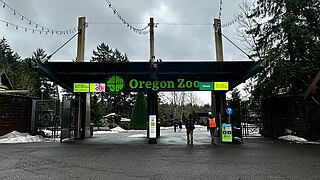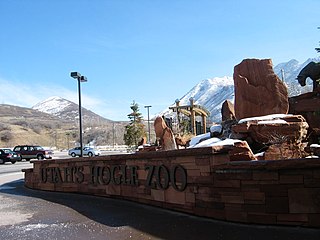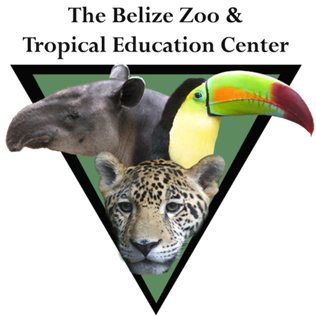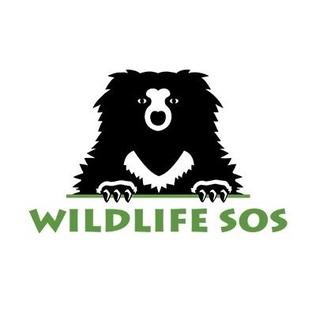
The San Diego Zoo is a zoo in San Diego, California, located in Balboa Park. It began with a collection of animals left over from the 1915 Panama–California Exposition that were brought together by its founder, Dr. Harry M. Wegeforth. The zoo was a pioneer in the concept of open-air, cage-less exhibits that recreate natural animal habitats.

The Oregon Zoo, originally the Portland Zoo and later the Washington Park Zoo, is a zoo located in Washington Park, Portland, Oregon, approximately 2 miles (3.2 km) southwest of downtown Portland. Founded in 1888, it is the oldest zoo west of the Mississippi River.

The Oakland Zoo is located in the Grass Valley neighborhood of Oakland, California, United States. Established on June 6, 1922, it is managed by the Conservation Society of California, a 501(c)(3) non-profit organization dedicated to the conservation of wildlife both locally and globally. The zoo is home to more than 850 native and exotic animals and is a member of the Association of Zoos and Aquariums (AZA).
The Born Free Foundation is an international wildlife charity that campaigns to "Keep Wildlife in the Wild". It protects wild animals in their natural habitat, campaigns against the keeping of wild animals in captivity and rescues wild animals in need. It also promotes compassionate conservation, which takes into account the welfare of individual animals in conservation initiatives. Born Free also creates and provides educational materials and activities that reflect the charity's values.

The Navajo Nation Zoological and Botanical Park is located in Window Rock, Arizona, the capital of the Navajo Nation. It is the only tribally owned zoological park in the United States and is notable among zoological facilities in that it labels its exhibits in the Native American Indian language of Navajo. Having been operated by the Navajo Nation Parks & Recreation Department since its inception in the early 1960s, it became part of the Navajo Nation Department of Fish and Wildlife in September 2006.

The Alaska SeaLife Center is a public aquarium and Alaska's only permanent marine mammal rehabilitation facility. It is located on the shores of Resurrection Bay in Seward. It opened in May 1998, and is dedicated to understanding and maintaining the integrity of the marine ecosystem of Alaska through research, rehabilitation, conservation, and public education. It is the only facility in the world specifically dedicated to studying the northern marine environment and the only one designed at the outset to combine research with public education and visitor components. The Alaska SeaLife Center generates and shares scientific knowledge to promote understanding and stewardship of Alaska's marine ecosystems.

Lindsay Wildlife Experience, formerly known as Lindsay Wildlife Museum, is a family museum and wildlife rehabilitation center in Walnut Creek, California. Lindsay is the first wildlife hospital established in the United States, and a popular family museum in the East Bay Area near San Francisco. Founded in Walnut Creek in 1955, the museum's programs "connect people with wildlife to inspire responsibility and respect for the world we share." The museum features a number of California wildlife exhibits, natural history specimens, and a special theater offering a look into one of the hospital's many wildlife treatment rooms. The rehabilitation center—still among the largest in the country—treats more than 5,000 injured, sick, or orphaned wild animals each year.

The Cascades Raptor Center is a nature center and wildlife hospital in Eugene, Oregon that specializes in raptor rehabilitation. As of November 2020, permanent inhabitants of the center include 37 individual birds from 21 species.

Wildlife rehabilitation is the process of caring for injured, sick, orphaned, or displaced wild animals with the goal of releasing them back into their natural habitat. It involves medical treatment, temporary housing, and specialized care for a variety of species, from birds and mammals to reptiles and amphibians. Wildlife rehabilitation combines veterinary science, wildlife conservation, and animal welfare to ensure that animals have the best chance for recovery and survival after facing challenges such as injury, disease, or human interference.

Utah's Hogle Zoo is a 42-acre (17 ha) Association of Zoos and Aquariums (AZA) and the World Association of Zoos and Aquariums (WAZA) accredited facility. Located at the mouth of Salt Lake City's Emigration Canyon, Hogle Zoo is one of the largest zoos in the Intermountain West, and houses over 800 animals representing 139 species.

The San Diego Zoo Wildlife Alliance is a nonprofit organization headquartered in San Diego, California, that operates the San Diego Zoo and the San Diego Zoo Safari Park. Founded in 1916 as the Zoological Society of San Diego under the leadership of Harry M. Wegeforth, the organization claims the largest zoological society membership in the world, with more than 250,000 member households and 130,000 child memberships, representing more than half a million people. The San Diego Zoo and San Diego Zoo Safari Park feature a combined 15,000 animals of 750 species, not all of which are displayed publicly.

The Belize Zoo and Tropical Education Center is a zoo in Belize, located some 47 kilometres (29 mi) west of Belize City on the Western Highway. Set in 12 hectares, the zoo was founded in 1983 by Sharon Matola. It is home to more than 175 animals of about 48 species, all native to Belize. The natural environment of Belize is left entirely intact within the zoo. The dense, natural vegetation is separated only by gravel trails through the forest. The Belize Zoo and Tropical Education Center receives over 68,000 visitors annually, with 15,000 being students, teachers, and parents.
The California Living Museum is a zoo in Bakersfield, California. The primary focuses are plants and animals that are native to California, specifically Kern County.
Secret World wildlife rescue is an animal rescue center and charity based in East Huntspill, near Highbridge in Somerset. Founded by Pauline Kidner in 1984, this charity specializes in the rescue, rehabilitation and release of British wildlife. They work on an 8 am – 8 pm basis 365 days a year, with a team of experts on hand for any casualty or orphan that may be brought in. Each year they rescue roughly 5,000 wild animals, from badgers and otters to swans and birds of prey.

The Bornean Sun Bear Conservation Centre is a wildlife conservation and research centre for improving animal welfare and rehabilitation of the Malayan sun bear. It also aims to raise public awareness about the plight of the sun bears and to raise conservation awareness about this species.

Hope for Wildlife (HFW) is a non-profit wildlife rehabilitation and education centre located on a farm in Seaforth, Nova Scotia, Canada. It was founded by Hope Swinimer in 1997 as The Eastern Shore Wildlife Rehabilitation and Rescue Centre. It got its current name in 2006. A television series, Hope for Wildlife, began documenting the centre's efforts in 2009.

Bannerghatta Biological Park, also known as the Bannerghatta Zoo, is a zoological garden located in the city of Bengaluru. It was initially a small zoo and picnic corner within Bannerghatta National Park (BNP) which was started in 1974. The bifurcation of the Biological Park and the National Park took place in 2002. The Bannerghatta Biological Park covers a total area of 731.88 hectares and includes a zoo, safari park, butterfly park and rescue centre. The Zoo Authority of Karnataka, the University of Agricultural Sciences, Bangalore, and the Ashoka Trust for Research in Ecology and Environment (ATREE), Bangalore, are collaborating agencies. For the convenience of the general public, the Governing Council of Zoo Authority of Karnataka had decided to rename Bannerghatta Biological Park as 'Bengaluru Bannerghatta Biological Park' (BBBP).

Wildlife SOS (WSOS) is a conservation non-profit organisation in India, established in 1995 with the primary objective of rescuing and rehabilitating wildlife in distress, and preserving India's natural heritage. It is currently one of the largest wildlife organisations in South Asia.

The Uganda Wildlife Conservation Education Center (UWEC), popularly known as Entebbe Zoo, is a conservation center where animals found in Uganda can be accessed.

















